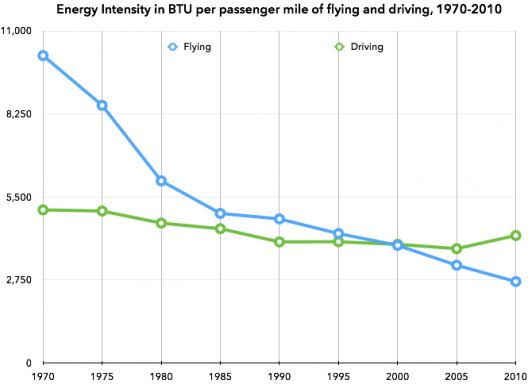Airliners beat cars in fuel economy, especially on longer trips. That would not be news to attendees at recent Electric Aircraft Symposia, where speakers like Ilan Kroo, Stanford University professor and aircraft designer, have brought that message home.
One of Kroo’s slides, shown below in a 2009 lecture (It’s nearly an hour, but worth a look and listen), lists a “narrow-body” airliner (in this case a Boeing 737-800) as able to fly one passenger coast-to-coast on 29 gallons of fuel, at about 81 passenger miles per gallon. A person carpooling his or her four-passenger Prius and driving responsibly could beat that (although not in the five hours required for the jet to make the total flight), but most trips are solo affairs, especially during commutes.
Not anywhere near Green Flight Challenge efficiencies (403.5 ppmg for the winning Pipistrel G-4), such economies are improving with more modern versions of fuel efficient airliners. Cars are also gaining in fuel economy, prompted by government mandates for 54 mpg goals in the next decade.
But University of Michigan research professor Michael Sivak says fuel economy for cars must improve 57 percent for “light-duty vehicles” to equal the current energy efficiency of commercial airliners.
Sivak, of the University’s Transportation Research Institute, looked at “the amount of energy needed to transport a person a given distance in a light-duty vehicle (cars, SUVs, pickups and vans) or on a scheduled airline flight.” Results were charted in British Thermal Units (BTUs) per person mile for different modes of transport between 1970 and 2010.
To achieve a 57-percent improvement, either the entire fleet of light-duty vehicles would have to improve from the current 21.5 mpg to at least 33.8 mpg, or car journeys would have to carry more people on each trip, up from the current average of 1.38 persons per vehicle to at least 2.3 persons.
The University’s report quotes Sivak: “It would not be easy to achieve either of these two changes. Although fuel economy of new vehicles is continuously improving, and these changes are likely to accelerate given the new corporate average fuel economy standards, changes in fuel economy take a long time to substantially influence the fuel economy of the entire fleet—it takes a long time to turn over the fleet.”
With 14.5 million light vehicles sold in 2012, even that number makes up only six percent of the total light vehicles on the road – the rest being older, probably less fuel efficient, and being older, less likely to achieve their once advertised mileage. A 57-percent uptick in mpg in a decade will be “a daunting task,” in Sivak’s words. It took the three decades from 1970 to 2010 to achieve a 65-percent gain in mileage – and that’s not counting the increased loads required to equal airliner performance.

Energy efficiency chart by U of M’s Michael Sivak shows increasing energy efficiency of aircraft, lesser change for small land vehicles
Cars would have to carry a 67 percent greater load – that 1.3 extra passenger to compete, and vehicles loads have been dropping since 1970. Flying has improved 74 percent in loads carried with less fuel in the last 40 years, compared to a 17-percent improvement for cars.
Sivak sums up, “It is important to recognize that the energy intensity of flying will continue to improve. Because the future energy intensity of flying will be better than it currently is, the calculations underestimate the improvements that need to be achieved in order for driving to be less energy-intensive than flying.”
Surprisingly, trains and motorcycles are more efficient per person mile than cars or airplanes. In 2010, drivers used a blazing 4,218 BTU per person mile while airliners used only 2,691. Amtrak trains ran tepid at a mere 1,668, motorcycles slightly warmer at 2,675 and transit buses nearing hotness at 3,347.
Lighter, stronger materials, improved internal combustion, and moves toward hybrid and electric power will see these numbers falling over time, with benefits to users and the planet.
